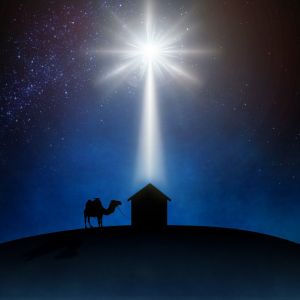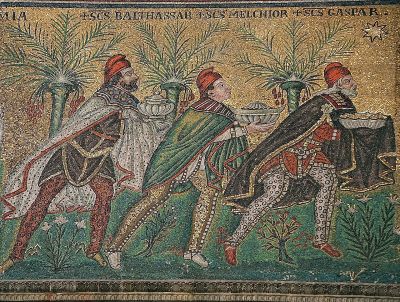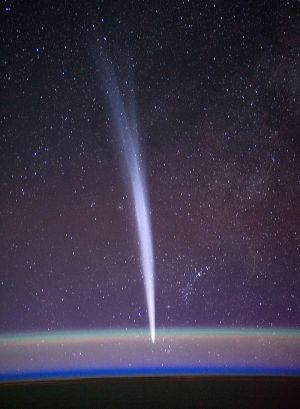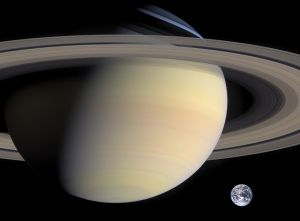The Star of Bethlehem
I know that is still discussed if Jesus was actually born in Bethlehem or Nazareth and I will get back that discussion in my next article. In this article I will just look into the story about the star that alledgedly led some "wise men" to the place where he was born, be that in Bethlehem, Nazareth or elsewhere. Today this star is known as The Star of Bethlehem or The Christmas Star. I actually wrote this article many years after my first articles had been published on my website, but in the English translations, I have moved up to where it actually belongs - at least in my opinion. Let me start by goingd through the words of the gospels,- or rather gospel, as only one gospel mentions a star.
The word of the gospel

The Star of Bethlehem, picture from Flickr
As mentioned in the first article
"When was
Jesus' lifetime?", only two of the gospels mention the birth of Jesus, and of
these two, only Matthew mentions a star - and wise men (or magi). In The Gospel
of Luke, Jesus is worshipped by shepherds who have been told of his birth by an angel, "and the glory of the Lord shone around them" (Luke 2.9) but it is the
closest Luke comes to a star. Matthew on the other hand has:
"After Jesus was born in Bethlehem in Judea, during the time of King Herod, Magi
from the east came to Jerusalem and asked, “Where is the one who has been born
king of the Jews? We saw his star when it rose and have come to worship him.”
When King Herod heard this he was disturbed, and all Jerusalem with him. When he
had called together all the people’s chief priests and teachers of the law, he
asked them where the Messiah was to be born. “In Bethlehem in Judea,” they
replied, “for this is what the prophet has written:
‘But you, Bethlehem, in the land of Judah,
are by no means least among the rulers of Judah;
for out of you will come a ruler
who will shepherd my people Israel.’
Then Herod called the Magi secretly and found out from them the exact time the
star had appeared. He sent them to Bethlehem and said, “Go and search carefully
for the child. As soon as you find him, report to me, so that I too may go and
worship him.”
After they had heard the king, they went on their way, and the star they had
seen when it rose went ahead of them until it stopped over the place where the
child was. When they saw the star, they were overjoyed. On coming to the house,
they saw the child with his mother Mary, and they bowed down and worshiped him.
Then they opened their treasures and presented him with gifts of gold,
frankincense and myrrh. And having been warned in a dream not to go back to
Herod, they returned to their country by another route." (Matt. 2.1-12)
Matthew has a lot of references to prophesies from The Old Testament, many
of which we are actually not able to refind today, and maybe they were just
inventions of the authpor of the gospel. But in this case we know which prophet
Matthew is referring to, namley Micah.
The Book of Micah chapter 5 verse 1 has:
“But you, Bethlehem Ephrathah,
though you are small among the clans of Judah,
out of you will come for me
one who will be ruler over Israel,
whose origins are from of old,
from ancient times.”
Even if the two quotes are similar, Matthew either used a version of Micah that
was different from the one we use, or he had to bent the content a bit to make
it fit his purpose. Maybe he counted on nobody actually knowing The Book of
Micah that well.
Micah does not speak of the village of Bethlehem but of the lineage Bethlehem (which
originated in the town) to which David belonged, and from which also the new
ruler should arise. This lineage is called small by Micah, but great (or at
least not the smallest) by Matthew. Matthew mentions the rulers of Judah, while
Micah only mentions the clans. Matthew also mentions Bethlehem in the land of Judah
while Micah only mentions Bethlehem Ephrathah, which could be translated into "from Bethlehem
toward Ephrath". Ephrathah was another settlement in Judaea not far from Bethlehem.
The Book of Micah was written about 725 BC when The Kingdom of Israel was
opressed by the Neo-Assyrian Empire and it's most likely that that the ruler
Micah is foreseeing has nothing to do with Jesus, but was someone who would free
Israel from this ongoing opression, and it is even suggested that the book was
not completed until after 515 BC when the Temple had been rebuilt and may have
referred to the opression by the Babylonian Empire instead. Anyway it fit well into
Matthew's storyline.
The Magi

Three Magi in a 6th-century mosaic from Basilica of Sant'Apollinare Nuovo in Ravenna, Italy
Most who have dealt with the case agree that
the magi or "the wise men from the East" was astrologers or astronomers (basically
the same thing at the time) from somewhere east of Judea, most likely Babylon or
Persia, that is, current Iraq or Iran. They may have been Zarathustrian priests
or other scholars, who studied the stars in the sky and some even believe that they may
have been Jewish scholars from Yemen, which at that time had a Jewish king and a
rather large Jewish Population. Later stories have turned the magi into holy men
or kings, and have fixed their number to three, but the gospel mentions neither
their number nor any titles except from magi. The number may have been adopted
into
the legend because they gave three gifts, namely gold, frankincense and myrrh.
Later legends even name the three, namely Caspar, Melchior and Balthasar, and they also received nationalities. Caspar was Indian, Melchior
was Persian and Balthasar was Arab. Some sources make Balthasar an Egypt and
Melchior a Greek, which would make it difficult for them to come from the east.
In the Syrian church, they are called Larvandad, Gushnasaph, and Hormisdas,
names that sound far more Persian. Other traditions know them by different
names, but as mentioned above the gospel doesn't say anything about names,
nationalities or number. Medieval sources claimed that they traveled by different
routes, but more likely they came from the same place and travelled together.
And now let me look into some theories about the star itself.
Was the star a supernatural phenomenon?
But what was it about the star that showed the magi the way to the newborn Jesus? The gospel suggests (and many if not all Christians believe) that it wasn't a natural phenomenon, but a "supernatural sign" that God had set in the sky to show them the way. This would also explain why it was apparently only the magi who noticed the star. Also the astrophysicist Jason Lisle, who belongs to the creationists, believes that the star was a sign from God. He states that the Star of Bethlehem, who went before the magi and eventually stood still over Bethlehem, would be in conflict with the laws of nature, but he states that God can disregard the laws of nature, if he needs to. Of course, Lisler is not alone in this view, but probably one of the few astrophysicists or astronomers who supports it.
The star as an allegory
Another possibility is that the "star" had to
be understood allegorically, as a symbol of God's grace by allowing his son,
Jesus, to be born as a human. He may have let this knowledge flow in some way to
the magi, for example, in their dreams. There are many other examples of
allegories in both The Old and The New Testament, so it is not impossible that
this is also an allegory. Allegorically, for example, is the star mentioned in Numbers
24.17, which states:
“I see him, but not now;
I behold him, but not near.
A star will come out of Jacob;
a scepter will rise out of Israel.
He will crush the foreheads of Moab,
the skulls of all the people of Sheth"
In this verse, the star clearly has to be perceived allegorically. Here, the
star symbolizes a man, a scepter (or ruler) of Jacob's lineage, who will destroy
Israel's enemies, so perhaps the star is simply an allegoric expression for
Jesus himself. He was thus the leader who led the magi to Bethlehem. By some Christians, the verse in Numbers is considered a prophecy of
Jesus the Messiah, although it
initially tried to predict a much nearer future, not least because the land of
Moab had long been gone at the time of Jesus. But this too may have to be read
allegorically and understood as enemies of the Jews in general. Who the people
of Sheht or Seth (sons of Seth in the Danish translation) is representing is more
unclear as Sheth (or Seth), the third son of Adam and Eve, in Judaism, is
considered the ancestor of all humankind, which is strange to me as also Cain
had children. Another interesting thing here is who was the mothers of Sheth's
and Cain's children as Adam, Eve and their children were the first people in the
world, but that is a discussion for another time.
The star as a pure astrological phenomenon
In this case an astrological phenomenon is defined as an event predicted by astrologers by laying out the movement of the planets and stars without other people being able to immediately observe the same. The theory is that astrologers have predicted the birth of a new king of the Jews, and then traveled to Jerusalem, where the king resided, only to be told that the new ruler was to be born in Bethlehem, where they then traveled. Of course, this theory assumes that one believes in astrology, but so does the astronomical explanations, see below. If birth could only be seen from the astrologers' interpretations, it can explain why only the magi saw the star, which then did not appear in the sky at all.
The star as an astromical phenomenon

Comet Lovejoy seen from satellite in orbit in 2011.
Comets
The comet that first comes to mind is Halley's Comet, which was visible in the
sky in year 12 BC, that is, 12 years before the year in which Jesus was born,
according to the calculations of 525. Of course, we know today that he was not
born this year, but some years before that, but 12 BC is probably too early
after all. Of course, there may have been another comet, but if so it would probably
have been mentioned by some astronomers of the time, Chinese astronomers in
particular, as they recorded every single celestial phenomena they observed. And
there are no records of comets between the 12 BC and year 4 BC, where Herod is
believed to have died. Some scientists believe that Herod may have died as late
as in 1 BC, but even in the three years that may be added, no comets were
observed. Furthermore, this later dating of Herod the Great's death is rejected
by other scientists, typically on the basis that Herod's successors, his sons
Arkelaos, Philip, and Antipas all claimed that their reign began in 4 BC.
A nova or a supernova
Another possiblity is that the star may have been a Nova or a Supernova (from "stella
nova" = "new star"). A scientific explanation for this phenomenon can be found at
eg
Wikipedia.
The Chinese astronomers I mentioned above actually recorded in the year 5 BC a
new star in the constellation Capricorn, which may have been a nova. This star
was visible for approximately 70 days and it would also have been visible from
the Middle East. The star would have been visible in the hours before dawn,
which is exactly what the Greek version of Matthew suggests that The star of
Bethlem was. However, a nova/supernova would not have moved so much that it
could first be seen in the west when the magi travelled from a place east of
Jerusalem, and later in the south (when the magi were going from Jerusalem to
Bethlehem). In disfavor of both the nova and comet theories, it is also argued
that both comets and novas were typically interpreted as signs of future
disasters, accidents or death, not as signs of joyous events like the birth of a
king. Therefore, neither of the two possibilities are very likely.
Jupiter
On certain occasions, it seems as if planets are stationary in the sky or are
even moving in the wrong direction relative to the fixed stars. This phenomenon
occurs when the movement of the outer planets is "overtaken" by the earth's
movement around the sun. This can be observed with the naked eye, but only if
you observe the sky nightly for an extended period of time. Of course, this
is most likely exactly what the magi did, but hardly the general public, and
that may explain why only the former saw the "star". From daily observations, it
will look as if the planet is going in a loop and at each end of the loop it
appears to be stationary for about a week. In 5 BC the planet Jupiter showed
such a so-called retrograde movement, according to author and astronomer Michael
Molnar. Also the now-deceased English journalist and MP, Ivor Bulmer-Thomas,
aired the same theory in an article in the Quarterly Journal of the Royal
Astronomical Society, combining it with the idea of a (or rather two)
conjunctions between multiple planets, see next section.
Planetary conjunction
The theory most scientists believe in (if any) is that "the star" was a
conjunction between two or more celestial bodies. During the relevant period of
time, there were several such conjunctions. A conjunction occurs when two or
more celestial bodies "meet" in the sky.
In 7 BC, there was for example a conjunction between the planet Jupiter and the
star Regulus in the constellation Leo, and in 2 BC another conjunction took
place between Jupiter and Venus. However, the conjunction that most scholars
believe could have been "the star" is a conjunction between Jupiter and Saturn
in 7 BC. This conjunction was visible in the constellation Pisces. Over a period
of several months, the two planets came very close to each other three times.
The first "meeting" was in May, the second in September and the third in
December. If this is correct, it is assumed that Jesus was born in late April or
early May 7 BC The magi departed as soon as they observed the first conjunction
and reached Herod's court at the time of the second. This harmonizes nicely with
the time such a trip on foot from Babylon to Jerusalem would typically would
have lasted. The magi must have stayed in Jerusalem for quite some time, however,
as the theory assumes that the last conjunction in December showed them their
way to Bethlehem, a trip of no more than 2 hours, and only that much if you don't walk too fast. Conjunctions between Jupiter and Saturn are very rare and occur
only at an interval of about 800 years, so for astronomers/astrologers it has
been an event of great significance.
Jupiter had several conjunctions with Regulus again in the years 3 and 2 BC. In
the same years, several other conjunctions took place, among these between Saturn and
Mercury (May 19th, 3 BC), Saturn and Venus (June 12th, 3 BC), and twice between
Jupiter and Venus (August 12th, 3 BC and June 10th, 2 BCE), but these
conjunctions can only be the explanation if Herod did not die in the year 4 BC
but some years later. Another possibility is a conjunction between Jupiter and
the moon in the constellation Aries in 6 BC.
Other conjunctions have also been proposed, including a possible conjunction
between Uranus and Saturn in the year 9 BC, or a conjunction between Uranus and
Venus in 6 BC. However, the latter two conjunctions are unlikely, although
Babylonian astronomers might have known Uranus more than 1,500 years before
modern science discovered it. Not least unlikely because Uranus is hardly visible to the
naked eye.
A combination of several signs
Bulmer-Thomas believed that the magi observed the first conjunctions in 7 BC
and that this increased their awareness of future "signs". In the year 6 BC
another sign appeared in the shape of a "near-conjunction" between Jupiter,
Saturn and Mars. In May 5 BC the retrograde movement of Jupiter could be
observed, which finally caused them to leave for Jerusalem. The retrograde
movement lasted for about four months, roughly the time their journey would have
taken, and when they reached Jerusalem, Jupiter stood motionless in the sky in the
south. According to Bulmer-Thomas, Jesus was thus born in 7 BC and the magi
reached Jerusalem in 5 BC when he was almost 2 years old, which fits nicely with the story of the Massacre of the Innocents.
Also
Greek word Matthew uses when referring Jesus, actually refers to a toddler, and
not to a newborn child, as most versions of the story claim, and how it is also
translated in the Danish edition of Matthew. The English edition that I have used just
refers to Jesus as a child though. Matthew uses the exact same word about Jesus
when the family returns from Egypt, and at that time at least he can't have been
newborn. But if two years had passed since the birth, why was the family still
lingering i Betlehem in stead of returning to Nazaret? I will look into that in
my next article, in which I will also take a closer look at the Massacre of the
Inno/cents.

Saturn, Star of the Jews
Astronomy and astrology
The explanation that most people (who believe in the story at all) tend to
believe, is the conjunction between Jupiter and Saturn in 7 BC. This is due to
the combination of the astronomical conjunction that took place and the
interpretation that astrologers of the time would have arrived at from these
"facts". Jupiter was
considered the star of "The Ruler of the World". Saturn was the star of the Jews,
the symbol of righteousness and the star of the Messiah. Pisces was the zodiac
sign of the Jews and was at the same time a symbol of the end of time. The
conjunction was thus a sign that the ruler who was to herald the end of time,
should be born among the Jews. This was also what the magi expressed when they
asked Herod, “Where is the one who has been born king of the Jews? We saw his
star when it rose and have come to worship him.” (Matt. 2.2) Herod, who was
neither an astrologer nor a scholar, had to summon the chief priests and the
tearchers of the law to be told. Once again in the Danish translation the word "newborn"
is used for Jesus while he English translation doesn't mention anything about
age. The birth, according to astrologers, took place at the time when Saturn
first became visible over the eastern horizon after being passed by the sun, the
so-called heliic rise. This time of day heralded in births, and this is also the
exact time that Herod would like to know from the magi. It also fit very well
with the "fact", that the magi had seen the star "rise", and had seen it again when
they travelled to Bethlehem. Thus, they have not necessarily been able to
observe a single phenomenon on the entire trip to Jerusalem.